Digital transformation requires a digital transformation strategy that, as any strategy, looks at the goals, current situation and how to move forward on a transformational journey in a way that makes sense and connects the dots. A look at key questions to ask for your digital transformation strategy.
Companies across the globe are digitally transforming as they are challenged to improve business processes and develop new capabilities and business models.
In an economic reality where entire industries are changing, actionable intelligence is the new currency. Data and information have become core business assets, sources of revenue and critical enablers in the information age.

In order to reap the benefits of new technologies, the next stage in that information age and the digital transformation economy, organizations need to be ready for accelerating evolutions, higher business agility and the increasing role of all forms of data and information.
Most importantly, they need to be able to develop a digital transformation strategy and build bridges in several areas, which are related with information, data, processes, technologies, human aspects and much more.
A digital transformation strategy starts with answering essential questions such as the what, why, how and who. A digital transformation strategy builds bridges between current state and desired long-term plan.
And as digital transformation by definition is holistic and requires integration and collaboration, a digital transformation strategy looks at building blocks and the bridges to connect them, as well as barriers and new bridges to overcome them.
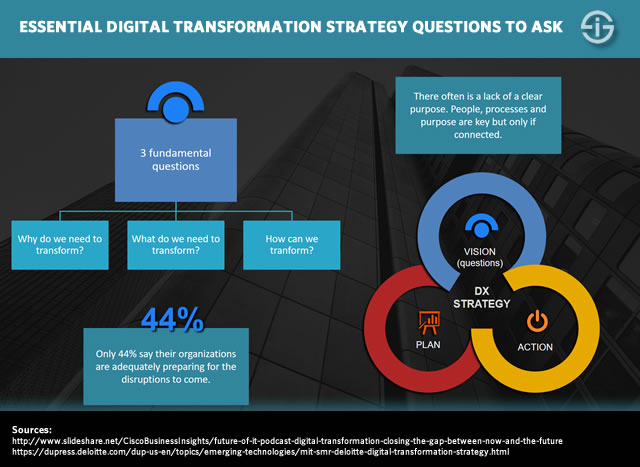
Digital transformation strategy: building bridges between IT and the business
In a business reality where ‘the business’, with a leading (yet, non-exclusive) role for marketing and the CMO, increasingly takes decisions on technology budgets, we see that it’s often hard for IT and information management professionals, who are essential in digital transformation, to speak the language of the CMO or other business executives, which traditionally didn’t belong to their ‘target audience’.
It’s one of the reasons why IT firms are building or acquiring ‘digital transformation consultancies’ with roots in marketing/business or even agencies, which can help them in properly understanding and addressing the needs of these a-typical audiences.
Effective change management is imperative to making the transformation from doing digital things to becoming digital (Deloitte, infographic below)
It’s also the reason why some consultancy-oriented firms, who have been very vocal in the digital transformation scope, encounter challenges of growth. They can’t respond to the increasingly end-to-end digital transformation strategy needs of companies as they miss the profound IT and information management skills.
In other words: for many of them it’s hard to build the bridges that are required in the holistic phenomenon that covers many realities and skillsets and is called digital transformation.
Building bridges between the business and information/processes
It’s not just the IT and information management people that struggle to speak the language of, let’s say, the CMO.
The other way around, many marketing executives, don’t speak the language of IT and/or are not used to think and work in terms of business process management, essential technological evolutions and concepts or methods of business process reengineering and/or business process optimization.
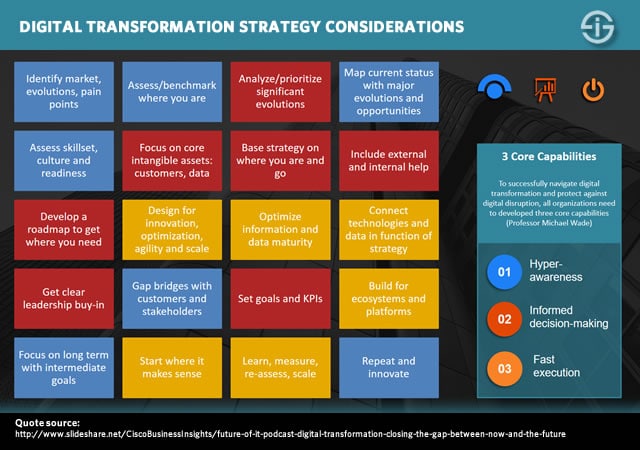
There are more bridges to build than just those between the ‘IT and information management side’ and ‘the business side’. We’ve covered this necessity previously from the perspective of information as a bridge builder in the next stage of the information age, whereby information bridges need to exist between back end and front office, content and processes (integration), human and machine and machine to machine (the Internet of Things), raw data and actionable intelligence, etc. It’s equally critical to integrate information/content and processes, with the business and knowledge worker in mind as previously mentioned.
To successfully navigate digital transformation and protect against digital disruption, all organizations need to developed three core capabilities says Professor Michael Wade: hyper-awareness, informed decision making and fast execution. More in the presentation, which we embedded below.
It’s probably not that hard to imagine how much bridging of processes, people, information sources and existing silos and gaps that requires.
Building bridges for actionable intelligence
Information is ubiquitous and at the center of digital transformation. Big data volumes, formats and sources keep growing exponentially. The question for leading companies has become: how do we turn all this data into actionable intelligence in a meaningful, prioritized and profitable way, leading to new opportunities.
At the same time, information management requires a holistic and integrated approach. From digitizing and capturing paper-based information to enhancing processes, empowering knowledge workers, better serving customers and getting the right information and intelligence when, where and how they are needed requires several steps and integrations.
Achieving end-to-end information management excellence, tailored to the individual goals and challenges of organizations, their customers, their ecosystems and their goals of optimization, innovation and, increasingly, digital transformation, is critical, if not the main pillar to succeed any digital transformation strategy. In practice, it requires building many bridges to remove gaps and chasms that are still prevalent.
Last but not least, it requires data/content analytics and (thus) artificial intelligence to move from information to knowledge and intelligence that is actionable.
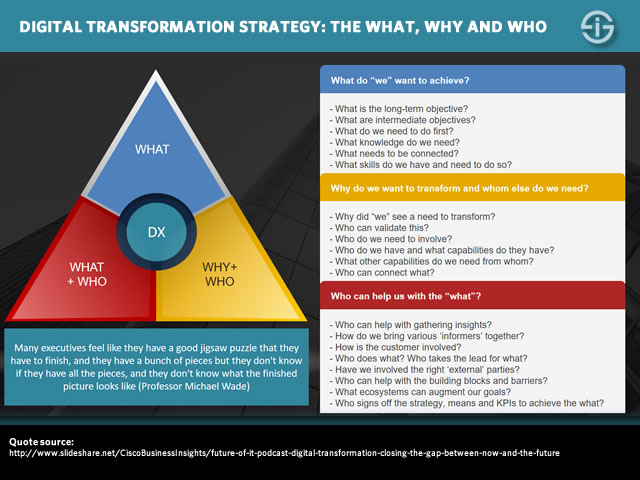
Building human bridges in a digital transformation strategy
There are ample bridges to be built from a human perspective. Customer-centricity, customer-facing processes and the end-to-end customer experience are key in digital transformation strategies. We need more and stronger bridges with customers in ways which require more depth and breadth (and personalization) than ever.
A digital transformation strategy also requires bridges between leaders and ‘their people’, among others those who are closest to the customers and often feel forgotten and unheard, bridges between various functions and, increasingly, between business execs and leaders from several companies who are building the ecosystems of value which are needed in an economy where new business models and revenue streams de facto increasingly dictate both the business and technology agenda. The customer in the broadest sense (external and internal such as employees, don’t forget change management) is the driver behind many bridges to build and instrumental in effectively building them.
Bridges to build new ecosystems
The strength of ecosystems and communities of innovation, collaboration and also outsourcing partnerships, defines the strength of the businesses which are part of them in a culture of co-opetition and co-creation.
Finding new revenue streams together by connecting systems of value and building bridges is key here as well, and is enabled by a technological reality that increasingly revolves around data, actionable intelligence, software and connectivity. This dimension will increase even more with the interconnection of everything and more actionable intelligence opportunities, what the Internet of Things or IoT is really about.
It’s clear that collaboration and co-creation, on top of the different meanings they already have (think internal collaboration, for instance), in a digital transformation economy and digital transformation strategy context go beyond the enterprise and existing ecosystems and move towards building new networks and ecosystems where data and actionable intelligence are leveraged for future growth and entirely new business models.
Co-opetition might be less known but in fact it’s an idea and practice that exists since several decades.
We invite you to read the classic ‘Coopetition‘, essentially meaning ‘cooperation and competition’, which Adam M. Brandenburger and Barry J. Nalebuff already wrote in 1996. It has always been in our top 10 of business books and in the holistic reality which business is and which digital transformation also is and requires to succeed, it could inspire you as it inspired us.
The reason we mention it is because co-opetition is also de facto what we see happening in several markets where so-called incumbents and so-called disruptive companies understand that it’s better to collaborate in competing for specific markets than to go in from purely competitive approaches. A typical example of that is happening in Fintech.
Speaking about disruptive companies, also note that, on top of describing a game theory strategy that redefines what competition and co-operation are, co-opetition builds upon a specific aspect of the, by definition holistic, industry attractiveness assessment model, widely known as the ‘six forces model, where ‘new entrants’ are one of the key forces.
Building bridges between technologies
Another area is the building of bridges between the capabilities of existing and ’emerging’ technologies and the potential they offer for the most innovative, who will win in the end.
While many companies already struggle with several of the previously mentioned bridges, this is where the real value can be created in an enterprise-wide and longer term digital transformation strategy (digital transformation needs a longer term view and strategy). We live in an age where over the past decades new technologies have emerged (some more recently) and gradually became core components of the ways we do business and the ways we live.
Their increasing maturity, as well as their increasing adoption, has led to what Gartner called the Nexus of Forces. On this site we often refer to the core technologies as the third platform (a term coined by IDC) or SMAC and sometimes SMACIT.
Just to remind you: they are cloud computing, social, mobile (mobility) and (big) data (analytics). With SMACIT we also include the Internet of Things. None of these ‘technologies’ are really new and often have their roots in other technologies we mention less or have forgotten about. On top of these so-called pillars new technologies are added, from 3D-printing to what IBM calls cognitive (and in the end is really about analysis and artificial intelligence).
The thing is that we often tend to approach all these technologies from a somewhat siloed perspective. It suffices to look at the traditional third platform depiction.
We do know that they are interconnected and strengthen each other, not for the sake of the technologies themselves but because in that Nexus of Forces they are inherently dependent of each other and simply overlap if you go deeper.
Bridging technologies and innovation
When you look at these various technologies, whether it’s from their individual traits and evolutions (books are written about each one as they cover many underlying realities and are all de facto umbrella terms) and when you look at how they are often covered, it’s easy to forget how they are really part of one single, more holistic, perspective, which is defined by the end goals why we ‘invented’ them and why we use them.
However, in order to reap the benefits and potential, it’s not enough to understand what you can with these technologies. It’s at least as important to understand how, in the end, they all matter in a context of your digital transformation strategy, actionable intelligence and opportunities. Most people realize that this end-to-end view matters to come up with innovative business approaches or novel ways to solve challenges of whatever nature.
At the same time we’re also forced to understand them individually. You really need to know what the Internet of Things is and can do, beyond what you believe it is and how important it will be. So, that is what we try to achieve. However, you should never forget that it’s important to build bridges between your understanding and the goals you want to achieve on one hand and the bridges to build between all the technologies that fit in your individual business context.
To do so, you need to grasp what role they play in the bigger picture of digital transformation, while identifying the glue that connects them and that in the end enables you to make a solid difference with your strategy. And that’s one of the areas where actionable intelligence (what data should become), speed/agility (what the cloud offers), hyper-connectivity and along with it more data (what the Internet of Things, mobility and so on offer), and the intersection of people, purpose, innovation, optimization, information, processes, value and business models come into play.
At the core of any digital transformation strategy: building bridges with the future
All the mentioned bridges need to be built. Because here is a reality: some forward-thinking companies have done amazing things using the Industrial Internet of Things and data analysis. They hook up with others with whom they can create new ecosystems of value. Others are doing or will do equally amazing things in other areas.
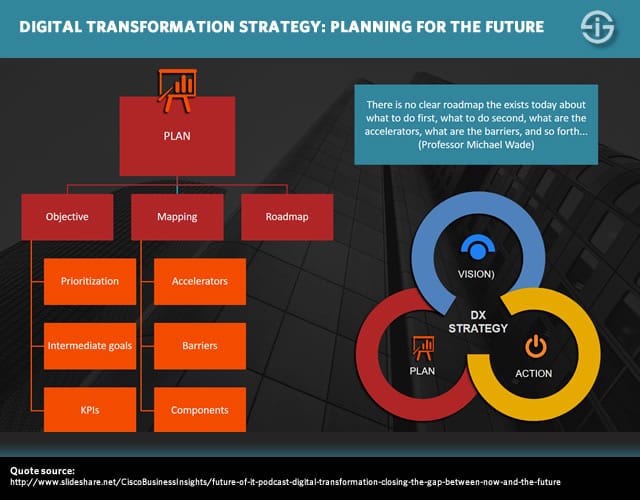
However, those that in the end will make the difference, will not be the technology innovators. It will be individuals and organizations that come up with entirely new ways of innovation and value creation by truly understanding how they can leverage the intelligence that is created in often seemingly unrelated areas by those first movers and, possibly by adding additional capabilities, and who can build bridges between sources and resources in ways we only start understanding today. And to do so, a holistic mindset, common sense, some distance and a profound understanding of how everything can be connected in the scope of a unique purpose are needed.
The question that arises is where do you start? The answer: by understanding all the components, technologies and others, we mentioned in this articles and building bridges on the essential levels where they aren’t constructed yet but where they should be in order to get that agile and holistic innovation and optimization capacity that stretches far beyond the hype of the day and is designed with a longer term strategy in mind.
How do you get to that strategy? By building bridges. By bringing people together that don’t get lost in the noise of the day but are able to see and…to build bridges. Between what you need to do now and what you will need to do next with the meaning, context, hyper-connectedness and purpose of it all in mind – certainly also on the longer term. Yet, that starts in the here and now and the basic operations, processes and models to improve and overhaul with an immediate business case, a medium term one and a bigger roadmap in mind.
Bridging intent and achievement: where do you want your digital transformation strategy to take you?
Digital transformation is not a thing, it’s partially a journey and partially a goal, but most of all it requires a clear roadmap and strategy with ample room for adjustment in an adaptive way.
The challenge for many executives is to know where they want to head, what they need to get there and how to be sure they successfully did get there with the necessary (intermediate) controls in place.
You can look at it from two angles.
On one hand we see that often digital transformation is seen as a set of projects, actions and exercises to do or a more enterprise-wide goal to achieve. If you look at it this way, inevitably you need to ask why do I want to transform anything whatsoever, what is that whatsoever and how am I going to get there as mentioned. Essential project management questions and forecasting methods are just a must, even if we tend to forget them and lose ourselves in the technological or organizational questions without the end in mind.
On the other hand we see that digital transformation is often approached as an ongoing journey that is more about a continuous business transformation strategy in the scope of technological and societal change. This is obviously a journey that never ends. It’s the development of a capacity to act, react and ideally pro-act as societal changes and technological evolutions continue to take place, accelerate and evolve.
It’s not because you have digitally transformed in the now, that there won’t be new occasions, challenges and chances, brought upon us by new technologies. The Internet of Things is just one example here as, in all honesty, we are still at the start. And there will be more changes and evolutions, far more.
The latter view explains why it’s so important to have a reactive (or agile), informed and highly ‘change-aware’ capacity. Digital transformation also means achieving this omni-informed capacity to act when action is needed or desirable.
Regardless of how you look at it, there is always one crucial challenge that comes back as just mentioned. However, it’s bigger in less project-based exercises. We hear this time and time again, whether we speak with experts in a specific domain such as the Internet of Things, CIOs, CMOs, information managers, you name it: all too often there is a lack of attention for the essential questions that also apply in digital transformation or any technological or other project or process.
What do you want to achieve, why do you want that, how do you get there, who do you need, is there a clear and calculated case that supports your intent and how are you going to gauge whether you achieved or not?
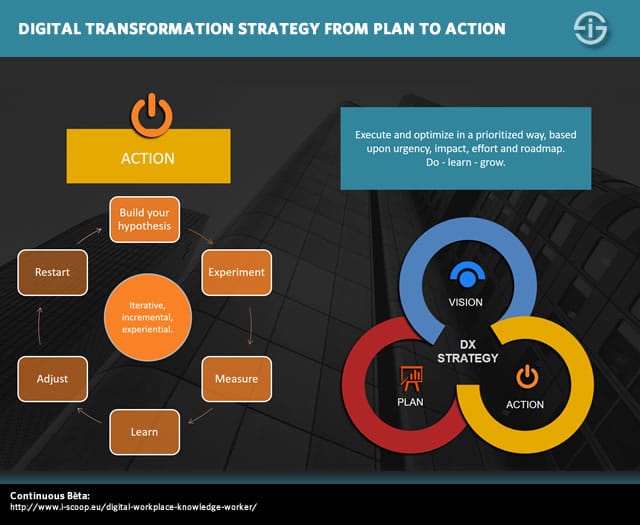
Bridging risk and certainty
While these questions seem obvious, there are numerous reasons why they are often overlooked and we don’t bridge the what, why and how or the intent and achievement.
One of many reasons is that often we are partially and in a sense by definition operating in relatively uncharted territory and aren’t sure if we have all the building blocks. That’s why it’s important to conduct VoC exercises and strategic sessions with various people. It’s also why it’s important to continue to learn, have a culture of evolution awareness and prioritize. Last but not least, it’s why we need a roadmap, as informed as possible, and as mentioned, with the necessary space for failure and balanced risk.
Compare the latter with marketing ROI. A good marketer will always strike a balance between activities with more certain outcomes and proven results and activities with less certain or uncertain outcomes which could be unexpectedly high gains or, if it doesn’t work that well, losses that don’t affect the overall ROI too much.
In exactly the same way and, depending on the scope and breadth/depth of the digital transformation strategy, chart the unknowns. What we often see in practice is that the mentioned challenge is not always a matter of uncertainty regarding outcomes but also a matter of uncertainty regarding the “how”: the uncertainty regarding what the outcome will look like (as we do speak about change and this something new) is then strengthened by uncertainties whether all the (right) building blocks are foreseen and/or in place to get there.
This uncertainty of missing building blocks or having the wrong ones is often what makes organizations uncertain as they fear failure in regards with the proper mapping of the needed building blocks (subprojects, people, processes, information sources, change management initiatives, built-in checks and so forth). Lean transformation with an adaptive case management approach, a focus on the 3Ps and room for failure and iteration as in a continuous Bèta model (more here) offer ways to tackle these challenges.
What you can learn regarding a digital transformation strategy from leading incumbents
Many leading ‘incumbents’ are increasingly setting up environments where they give room to innovation, experimentation and future-oriented sessions, in order to shape their digital transformation strategy.
They invite start-ups, newcomers, the often younger generations of technologists who master emerging technologies and/or their existing IT partners (who are also challenged) to showcase, collaboratively think, find talent and potential future scenarios, etc. They set up hackathons, organize brainstorming session days and launch trials in order to prepare for the longer term, as they decreasingly rely upon those first moving ‘digital transformation experts’ who have been repeating the same stories too long too often.
In more than one sense you can compare this trend and the challenge of several pure digital transformation consultancies , too often operating as islands of limited expertise who start feeling that they need to broaden their scope, with the evolutions before the dot come bubble when huge ‘e-business’ specialists went bankrupt one after the other and only a small portion more or less survived. Many have forgotten the names of various of these large players of the early days of the Internet and what used to be called ‘e-business’.
The comparison with that period is not a coincidence. We don’t just see many digital transformation consultancies facing challenges of scale and capabilities, we also see that in several areas of emerging technologies, specifically the Internet of Things, the narrative is mainly about numbers, which in the end are meaningless for execs, and about the technologies, from connectivity to hardware and software. This will change as the market matures, just as it did before the dot com bubble when numbers, predictions and the tech talk dominated the debates very often as well, leading to inflated expectations and hype. Will there be a new bubble? There always is one, you just don’t know how big it will be and which areas will be most affected.
Your digital transformation strategy and asking the right questions
The main question is: do you build all these bridges and define the goals, set out the strategy and journey, map the required building blocks and barriers, and look at your digital transformation strategy and roadmap in a smart way, regardless of all those frameworks out there and, rather, creating the right conditions to get you going?
Unfortunately this is still rarely the case and many don’t have a clear goal and overview of building blocks, barriers and bridges to build yet. Stay tuned as we’ll look deeper into digital transformation strategy and a framework/roadmap that guides your strategy by asking the right questions and connecting the right dots.
Here are two things you can already start doing as of right now:
- get any ‘digital’ expertise and culture out of its splendid isolation and let it penetrate the rest of your organization,
- look at where the leaks in your business are and where it’s clear that you’ll need to remove or bridge legacy and necessity, among others in the technologies that are crucial to scale and move faster and better once your strategy is in place.
Some digital transformation strategy steps to take into account (and that can be put in the context of the previously mentioned three core capabilities, as well as the, also previously depicted vision, plan, action steps):
- Identify market, evolutions, pain points.
- Assess/benchmark where you are.
- Analyze/prioritize significant evolutions.
- Map current status with major evolutions and opportunities.
- Assess skillset, culture and readiness.
- Focus on core intangible assets: customers, data.
- Base strategy on where you are and go.
Include external and internal help. - Develop a roadmap to get where you need.
- Design for innovation, optimization, agility and scale.
- Optimize information and data maturity.
- Connect technologies and data (sources) in function of strategy.
- Get clear leadership buy-in.
- Gap bridges with customers and stakeholders.
- Set goals, KPIs and controls.
- Build for ecosystems and platforms.
- Focus on long term with intermediate goals.
- Start where it makes sense (calculated).
- Learn, measure, re-assess, scale, innovate.

Digital transformation strategy – aligning the organization for its digital future – infographic Deloitte University Press 2016
Top image: Shutterstock – All other images are the property of their respective mentioned owners.

